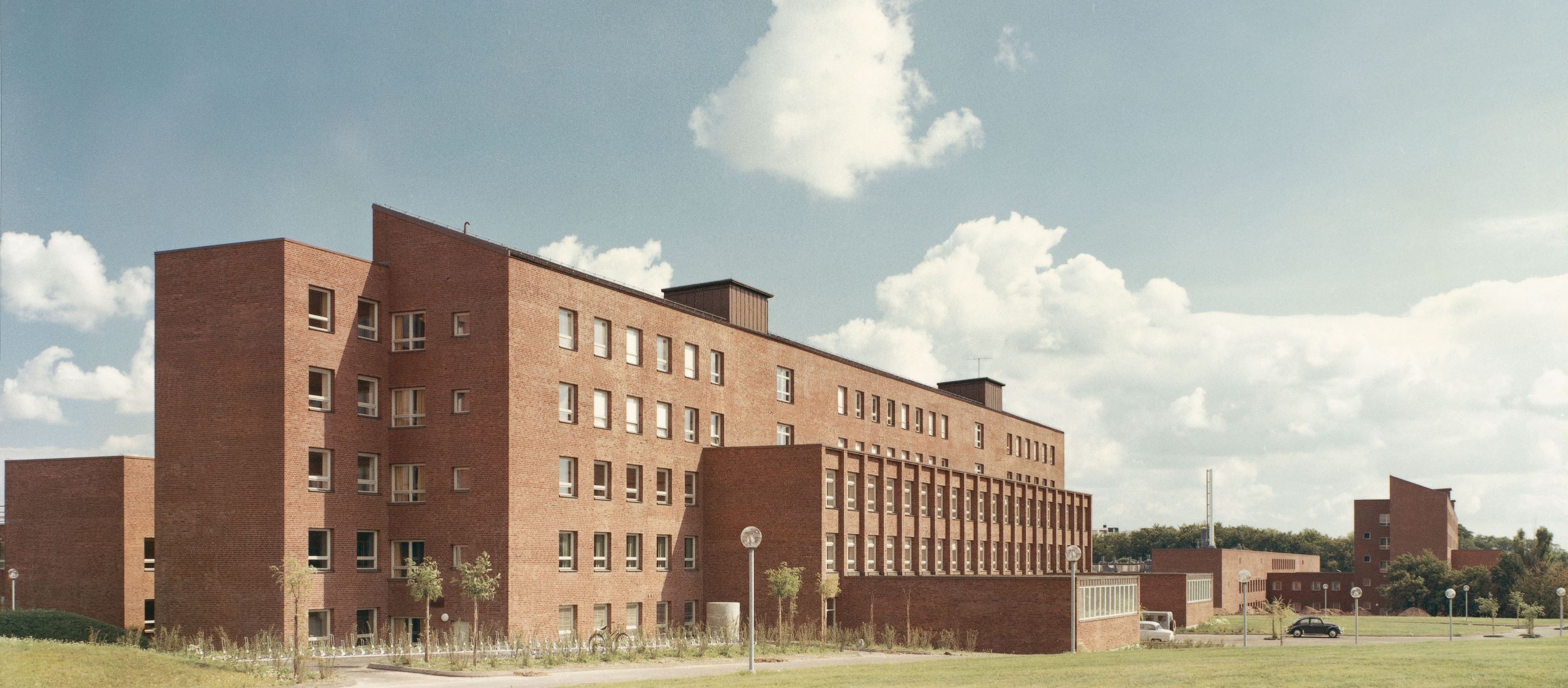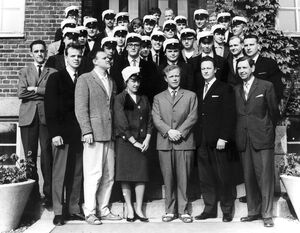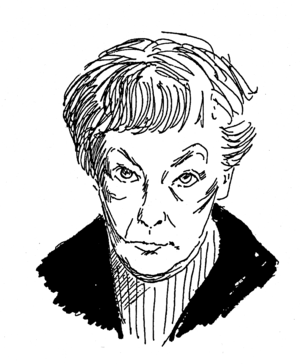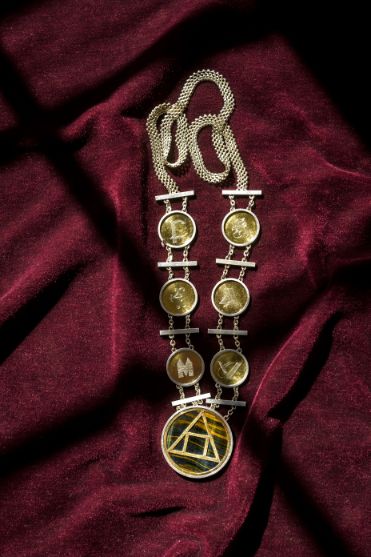
LTH: Sweden’s third institute of technology ended up in Lund
In 1961, the first 30 engineering students were admitted to the then independent Lund Institute of Technology (Tekniska högskolan i Lund, abbreviated in Swedish as LTH). LTH grew rapidly and a completely new campus grew on the edge of the city. Gradually it became both part of Lund University and a centre of knowledge on the Knowledge Highway between the main University building and Science Village.
From the late 1800s, Sweden began to profile itself as one of the world’s leading engineering nations. The Royal Institute of Technology (KTH) in Stockholm had been established in 1827 and the Chalmers University of Technology (CTH) in Gothenburg in 1829, even though both these institutions did not offer higher education programmes in engineering in the modern sense when they were founded. Industrial and technological progress had transformed Sweden from a poor and undeveloped country into one of the world’s richest.
After 1945 it was clear that if Sweden was to maintain this leading position, it would have to invest in research and development. Increased industrialisation in post-war Sweden and rapid technological development led to a rise in demand for engineers. This requirement, combined with the requests from industry in the region and the Skåne Engineers’ Association meant that densely-populated Skåne emerged as the best place to establish a third institute of technology.
The discussions about a third institute of technology took time and perhaps in the end it was the space race and the first man to journey into outer space in 1959 that helped to get the decision made. At least if we are to believe Lars Ingvar who was the secretary of the organising committee tasked in June 1960 with launching a new institute of technology in Lund. In the book “LTH 25 Years”, he writes that interest in the space race between the USA and the Soviet Union was a wake-up call and more and more people saw what an investment in technology could mean.
Would the institute be established in Malmö?
Initially, the eventual location of an institute of technology in Skåne was an open question. Malmö was one of Sweden’s most important industrial cities and had one of the country’s first technical high schools, which was founded as early as 1850. “From the start, it was self-evident that an institute of technology in southern Sweden would be located in Malmö”, wrote Harald Nerman, who was a member of Malmö’s Higher Education Committee, in “LTH 25 Years”. Malmö’s Higher Education Committee and the Skåne Engineers’ Association gathered together arguments as to why the institute of technology should be located in Malmö.
However, Lund was chosen in the end. One important reason for this decision that is usually mentioned is the powerful argument of Lund University’s vice-chancellor Phillip Sandblom, who saw before him a robust expansion of the University through an engineering faculty. That’s not how it turned out at the time, but the organising committee saw that the new institute of technology and Lund University would both benefit from being in each other’s proximity. The committee was led by KTH’s vice-chancellor Ragnar Woxén, who wanted to see an independent institute of technology outside of Lund University – and that’s how it started.
The new Lund Institute of Technology, abbreviated right from the start as LTH, was structured as an institute very much like KTH. The committee’s aim was that KTH, CTH and LTH would be equivalent, but not identical. Among other things, LTH had Sweden’s first professorships in electrical measuring techniques, electric automation, building materials analysis and building function analysis. LTH’s first professor, and the first vice-chancellor of its own, was Bertram Broberg (solid mechanics). From 1961 to 1965, Ragnar Woxén was the vice-chancellor of both KTH and LTH.
It was decided at the start that the institute would have six divisions: engineering physics (F), electrical engineering (E), mechanical engineering (M), roads and water (V), architecture (A) and chemistry (K), forming the Swedish acronym ”FEMVAK”. The institute would generally introduce one new study programme per year, and by 1965 had six programmes running. The first was engineering physics, as it contains relatively many theoretical subjects and did not require particularly specialised laboratories. In addition, recruiting teaching staff was relatively easy, as some of the subjects during the first academic years were already taught at the University.
The first roll-call

LTH’s first roll-call took place on 3 October 1961. Twenty-eight men and two women were present for the roll-call in hall VI of the main University building. After the roll-call, it was time to head over to the Academic Society Building and celebrate. ”Participating on behalf of Lund University was the vice-chancellor Philip Sandblom and from the students’ union, the president Erik Owers. We then went in a procession to the Academic Society Building where Owers offered champagne and declared the institute inaugurated”, wrote the head of the faculty office Lars Ingvar at the time of the 25th anniversary. LTH’s first professor Bertram Broberg recollected in the 1972 Academic Society Yearbook that the students’ union president offered sherry and he also observed that it was a simple ceremony: ”One of the engineering students had a harmonica, but there was no music in the end.” In the evening, the Skåne Engineers’ Association invited the students to dinner at the City Hall in Malmö. Later in the week, the students travelled to Gothenburg to visit Chalmers for orientation, as naturally there were no older engineering students in Lund.
As LTH had no premises, it used the old primary school teacher training college by the hospital. Laboratory sessions were held in a building behind the then Zoological Museum. However, the problem of premises would soon be solved – an enormous construction project was started that would quickly build a new institute. “The Lund Institute of Technology is the first major higher education institution in Sweden for which all the buildings have been planned and built as a cohesive whole” noted Sixten Larsson, the general director of the National Board of Public Building, in a publication about the project in 1965.
Klas Anshelm designed LTH
Klas Anshelm was the architect tasked by the National Board of Public Building to design LTH. Before Klas Anshelm got to grips with what was to become his biggest project, he was well-known in Lund for buildings such as the art museum Lundskonsthall, the hospital St Lars sjukhus, Lunds nation, the extension of the University Library and perhaps above all for Medicinarlängan, now the Biomedical Centre (BMC), which in 1949 was a completely new type of institutional building, far removed from the institutional palaces of previous times.
The new institute was built on a field outside Lund – and today LTH is on the way to becoming a centre of knowledge on the Knowledge Highway, which includes a tramway and stretches from the main University building to Science Village.
The materials used for LTH were brick masonry on a cast concrete framework. When doubts were expressed about the financial aspect, Anshelm stood his ground and showed that his methods were less expensive than others that were proposed.
There was so much brickwork that the bricks, if laid end to end, would stretch from Lund to Rome. The colour scheme – black asphalt and roof, dark red brick, grey concrete and white wood elements – was chosen by Anshelm so that the buildings would not become dated. Anshelm would not have seen it as part of his assignment to predict what would be modern in 40 years’ time.
The last phase was the construction of the Centre for Chemistry and Chemical Sciences (Kemicentrum) which, with a 273-metre-long mid-section (the equivalent of three Lund Cathedrals) housing equipment halls and laboratories, became Lund’s longest building when it was completed in 1968.
In the early years, the appointment of professors could not be administered in Lund, as LTH did not have a sufficiently large group of professors. So these matters were handled at KTH, but the faculty was enlarged with the LTH-appointed professors and also in certain cases by professors from CTH and the Mathematics-Science Faculty at Lund University. In 1964, LTH formed its own faculty, which was, however, expanded in the first few years with professors from KTH and CTH and in some cases from Lund University.
On 28 October 1965, LTH could be inaugurated in a real sense. Now, all the planned FEMVAK programmes were in place, large parts of the campus, except for Kemicentrum, had been completed and LTH had a sufficient number of professors. However, one thing that LTH did not have in place was its own seal or emblem, so for the inauguration LTH asked the Engineering Students’ Union (TLTH) for permission to borrow their square–triangle–circle symbol. It turned out to be a long-term loan, as the symbol subsequently became LTH’s emblem until the 1990s when TLTH took, or got, the emblem back. Despite this, the symbol remains a part of LTH’s soul. LTH’s doctor’s ring is a variant of the symbol, and the doctor’s hat and the tailcoat collar of doctoral graduates sport the emblem, as does the LTH dean’s chain of office.
Lund’s first female professor

Lund’s first female professor, Carin Boalt, was inaugurated among the first 28 professors at LTH. Even though in 1965 Carin Boalt was the first woman to become a professor in Lund, she was technically not the first at Lund University, as LTH was still independent.
In 1967, the organising committee proposed that LTH should continue as an independent institute. However, it was not unanimous and several influential figures from Lund University on the committee were against the proposal. The crucial decision was taken by the Swedish parliament in spring 1968, which led to LTH being incorporated into Lund University on 1 July 1969 as its Faculty of Engineering. It was felt by the powers that be that the established abbreviation LTH could be retained. The incorporation into Lund University was probably made easier by the fact that LTH’s dean, Sven Johansson, won the election for vice-chancellor of the University the same year and took up the position in 1970.
Initially, there were mutterings here and there at LTH about the institute having to relinquish its independence. Perhaps the engineering students’ drive in 1978 to raise funds from industry in Skåne for a chain of office for LTH’s dean can be seen as a reaction showing that, at the time, they were not satisfied with LTH’s role within the large University. LTH’s dean would indeed also have a chain of office to wear on ceremonial occasions – just like the Vice-Chancellor of Lund University.
In the 1980s, the large University was called into question for being unwieldy, and an inquiry by the Swedish National Board of Universities and Colleges (UHÄ) concluded that the large-scale organisation in Lund had considerable disadvantages. However, instead of detaching LTH, a new large higher education institution was created, the Lund Institute of Technology and Science (Tekniska och Naturvetenskapliga Högskolan i Lund – Swedish abbreviation LNTH), which included two faculties – Engineering and Mathematics-Science. So in 1984, LTH became an institute within a higher education institution within a university!
LNTH had a Vice-Chancellor, but LTH and the Mathematics-Science Faculty each had a Dean. LTH’s Dean at that time, Skotte Mårtensson, stated in the book ”2001 – an LTH Odyssey” that not unexpectedly the two cultures experienced cooperation problems. There was a lot of suspicion on both sides and most of the matters under discussion were about “small potatoes” – issues that were not overly significant, but on which everyone could have an opinion.
After five years, the large higher education institution was broken up and the broad consensus was positive. On July 1, LTH again became an institute within a university. Over the years, LTH has found itself to be well-placed within LU and is now a large and self-evident part of the University.

The LTH Dean’s chain of office
The chain of office worn by the Dean of LTH on ceremonial occasions was made by the silversmith Birger Pellas in 1978.
The LTH Dean’s chain of office can be said to be designed according to the same principles as the chain of office of the University’s vice-chancellor. It consists of a large medallion depicting LTH’s then square–triangle–circle emblem, where the University has its seal, and six smaller medallions, which represent the original divisions as an equivalent to the University’s medallion for the four original faculties. The chain is made of silver, whereas the University’s is of gold.
